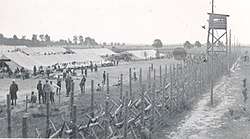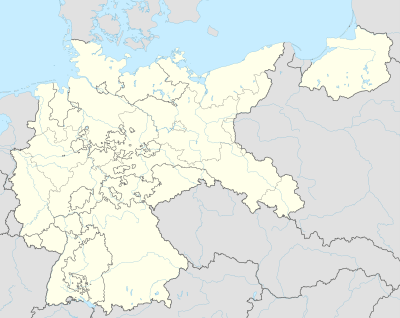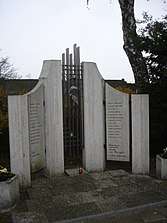Stalag II-D
Stalag II-D Stargard (American named, "Camp #86") was a World War II German Army Prisoner-of-war camp located near Stargard, Pomerania (now Stargard, West Pomeranian Voivodeship, Poland), about 30 kilometres (19 mi) east of Stettin (Szczecin).
| Stalag II-D | |
|---|---|
| Stargard, Pomerania | |
 Stalag II D Stargard, in 1939-1945. | |
 Stalag II-D | |
| Coordinates | 53.32°N 14.98°E |
| Type | Prisoner-of-war camp |
| Site information | |
| Controlled by | |
| Site history | |
| In use | 1939–1945 |
Camp history
The camp was established as a temporary camp Dulag L on a military training ground in September 1939 to detain Polish soldiers and civilians taken prisoner during the German September 1939 offensive, which started World War II.[1] For the first few months they lived in the open or in tents during a very cold winter, while they built the wooden and brick huts for the permanent camp. In October 1939 the Dulag L camp was transformed into the Stalag II-D camp.[2] Polish military officers were imprisoned in the camp until December 1939, and Polish civilians until January 1940.[3] Later also other groups of Polish soldiers were held in the camp.
In May and June 1940 American, French, Dutch and Belgian soldiers taken prisoner during the Battle of France arrived. These were followed by Soviet prisoners from Operation Barbarossa in the summer of 1941. In September and October 1943 Italian prisoners arrived after the Italian capitulation. Canadian prisoners from the Dieppe Raid of August 1942 were transferred to Stargard from Stalag VIII-B in January 1944.
Germans introduced racial segregation, and Poles, Africans, Arabs, Jews and Soviet troops were separated from POWs of other nationalities.[3] Germans carried out medical experiments on Moroccans, Tunisians and Senegalese.[4] There were about 4,600 prisoners from these African countries, and there was a high mortality rate among them, although from summer 1940 they were gradually transported to other camps located in southern France.[5] Serbs also faced noticeably more severe treatment.[6] Hundreds of Soviet POWs were deported to Nazi concentration camps.[7] Italian POWs were deported to Meppen, to a subcamp of the Neuengamme concentration camp, in November 1943.[8]
The POWs were often used for forced labour in over 1,500 subcamps located in the region.[9]
Late arrivals were Americans, NCOs from the Battle of the Bulge, who left Stalag XIIA Limburg on January 15, 1945 by rail to arrive on January 19, 1945. The camp was liberated by the Soviet Red Army in mid-April 1945.
Evacuation and repatriation
The first evacuation occurred on 29 January 1945 in blizzard conditions.[10] The count was held up the morning of the march as the MOC (Man of Confidence) was in negotiation with the Kommandant for the safety of the men who were too sick for the march.[11] Many of the sick and infirmed were left behind in the Lazzarett (camp clinic) and were transported by rail or truck at a later date. Almost a thousand men struggled into formation. There were about five-hundred Russians, two-hundred Frenchmen, one-hundred Americans and twenty-five Canadians in the march.[12] Other reports have the number at as many as two-thousand in the column.[13] They were marched twenty-five or thirty kilometers that day. Then were put into a barn, under guard, and slept for the night. Every evening the guards would dump out the meal for the day on the muddy earth. Everyone would scramble for what they could get. In the morning, they were given two slices of bread, counted, and the march began again for twenty-five or thirty kilometers until they reached the next appointed village.[14] Those who fell to the side of the road were rumored to have been shot, but were more likely to have been loaded onto the “dead cart” at the end of the column used to carry the dead, dying, and sick all piled into the cart together and carried to the next stopping point.[15] After two, maybe three days, the column reached Settin. The sick and the dead were left at Settin while the majority of the rest were moved on to Stalag 2A, Neubrandenburg where they arrived on 7 February 1945. The eight-day total distance of the march was 70–90 miles (120-150 Kilometers).
On 25 February 1945 most of the remaining prisoners were forced to march westward in advance of the Soviet offensive and endured great hardships before they were freed by Allied troops in April 1945.
Living conditions
The lower ranks prisoners at this camp fared much better than those in many other camps further south. They worked predominately on farms and had the possibility to obtain better nourishment.
Escape
It was relatively easy to escape from a farm, but much more difficult to evade recapture. Prisoners working on farms did not have the essential assistance that was provided in Oflags by teams of dedicated specialists who forged documents and prepared maps. Without these it was extremely difficult to traverse hundreds of miles past frequent checks by the Nazi police.
Gabriel Regnier, a French prisoner, describes his failed attempt with a French companion on 23 March 1942. A Polish civilian worker at the farm had helped them by hiding civilian clothes for them. It was a dark night and they successfully reached a freight train that was switching cars at the station that was close to the farm. They successfully hid in one box-car full of boxes. But then the train stopped in Stettin for unloading, they switched to another car loaded with sacks of barley destined for Aachen in western Germany, which they reached four days later. There again they got out to search for a car going to the Netherlands. Unfortunately the driver of a vehicle noticed two persons moving hesitantly along the train and alerted the military police. Recaptured they were returned to Stargard and spent 24 days in solitary confinement. It could have ended much worse.
Sources
See also
- List of prisoner-of-war camps in Germany
- Stalag
- Gerald MacIntosh Johnston
References
- Jolanta Aniszewska, W obowiązku pamięci... Stalag II D i formy upamiętnienia jeńców wojennych w Stargardzie Szczecińskim, "Łambinowicki rocznik muzealny", Tom 34, Opole, 2011, p. 9, 14 (in Polish)
- Aniszewska, p. 9
- Aniszewska, p. 14
- Aniszewska, p. 16
- Aniszewska, p. 16-17
- Aniszewska, p. 17
- Aniszewska, p. 18
- Aniszewska, p. 19
- Aniszewska, p. 20
- MacKnight, George G., POW Diary.
- Burke, James H., Fünf Mann – A Prisoner of War Story. Skaneateles, New York: Meredith Press, 1999.
- Haugh, Edwin A., “At Front After 12 Years in Army, Haugh Was Captured One Week Later,” The Flash, December 2001, The 78th (Lighting) Division Veterans Association, Pittsburgh, PA.
- West, Robert P., “Captured in Kesternich,” The Flash, March 1993, The 78th (Lighting) Division Veterans Association, Pittsburgh, PA.
- Lederman, Sol, “KESTERNICH and BEYOND,” The Flash, June 1993, The 78th (Lighting) Division Veterans Association, Pittsburgh, PA.
- Tenenbaum, Leon (S/Sgt., 78th Infantry Division, 310th Infantry Battalion, Company G, 2nd Platoon), Interview by Tom MacKnight, August 10, 1999.
| Wikimedia Commons has media related to Stalag II-D. |

